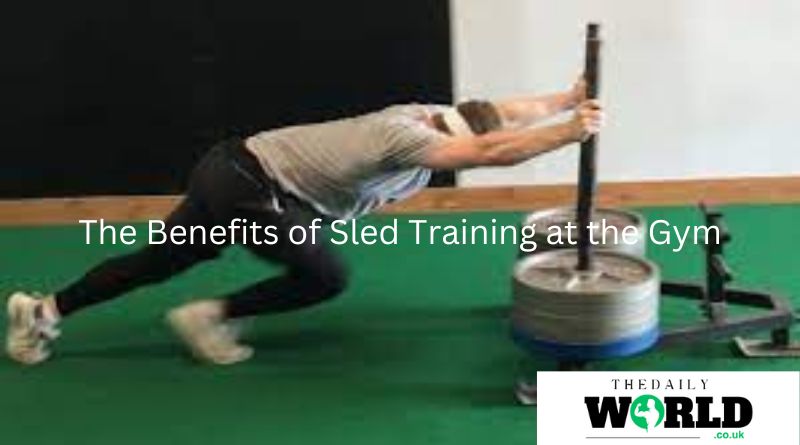Sled training is often associated with athletic training and sports performance, but its benefits extend far beyond the realm of professional athletics. Incorporating sled training into your gym routine can offer a wide range of advantages, from improved strength and endurance to enhanced mental toughness and injury prevention. This article explores the myriad benefits of sled training at the gym, making a compelling case for why you should add this versatile piece of equipment to your workout regimen.
Comprehensive Full-Body Workout
One of the most significant benefits of sled training is its ability to provide a comprehensive full-body workout. Unlike traditional gym equipment that targets specific muscle groups, sled training engages multiple muscles simultaneously. Pushing or pulling a weighted sled requires the coordinated effort of the legs, core, back, and arms, making it an effective exercise for developing overall strength and muscle tone.
When you push a sled, your quadriceps, hamstrings, and glutes are the primary muscles at work, driving the movement forward. At the same time, your core muscles engage to stabilize your body, preventing unnecessary movement and maintaining balance. Pulling a sled engages the upper body muscles, including the biceps, triceps, and shoulders, as well as the core and lower body. This full-body engagement not only builds strength but also promotes functional fitness, improving your ability to perform everyday tasks with ease.
Enhanced Cardiovascular Fitness
While sled training is primarily known for its strength-building benefits, it also offers a robust cardiovascular workout. The continuous, high-intensity nature of sled exercises increases your heart rate and challenges your cardiovascular system, making it an excellent form of cardio. Whether you’re performing sprints with a light sled or pushing a heavy sled for shorter distances, the aerobic and anaerobic demands of sled training can improve your cardiovascular fitness and endurance.
The cardiovascular benefits of sled training are particularly valuable for those looking to burn calories and lose weight. The high-intensity nature of sled workouts accelerates calorie burn, both during and after the exercise, due to the afterburn effect. This post-exercise oxygen consumption (EPOC) means your body continues to burn calories at an elevated rate even after you’ve completed your workout, enhancing fat loss and improving overall body composition.
Low-Impact, High-Reward Exercise
Another notable advantage of sled training is that it provides a low-impact workout while delivering high rewards. Unlike running or jumping exercises that can put significant stress on the joints, sled training involves controlled, smooth movements that reduce the risk of joint injuries. This makes it an ideal exercise for individuals of all fitness levels, including those recovering from injuries or dealing with joint pain.
The low-impact nature of sled training also makes it a suitable option for older adults or those new to exercise. It allows them to build strength and endurance without the risk of overloading their joints. Additionally, because the resistance can be easily adjusted by adding or removing weight, sled training can be tailored to suit individual fitness levels and goals, providing a scalable workout option for everyone.
Improved Athletic Performance
For athletes and fitness enthusiasts, sled training can significantly enhance athletic performance. The dynamic, full-body nature of sled exercises mimics the movements and demands of many sports, making it an effective training tool for improving speed, power, and agility. Sprinting with a sled, for example, increases the resistance your muscles must overcome, leading to greater strength and speed gains over time.
Moreover, sled training helps improve neuromuscular coordination and movement patterns. The resistance of the sled forces you to engage your muscles more effectively, enhancing muscle recruitment and improving overall movement efficiency. This translates to better performance in sports and other physical activities, where quick, powerful, and coordinated movements are essential.
Versatility and Variety in Training
One of the most appealing aspects of sled training is its versatility. The sled can be used in a variety of ways to target different muscle groups and achieve different fitness goals. From pushing and pulling to dragging and sprinting, the possibilities are virtually endless. This versatility allows you to keep your workouts fresh and exciting, preventing boredom and promoting long-term adherence to your fitness routine.
For example, you can perform sled pushes to build lower body strength, sled drags to target the posterior chain, and sled sprints to improve speed and cardiovascular fitness. You can also incorporate upper body exercises, such as sled rows or sled presses, to work the upper body muscles. The ability to vary the intensity and type of exercises makes sled training a valuable addition to any workout program, whether your goal is to build muscle, lose weight, or improve athletic performance.
Enhanced Mental Toughness
Sled training is not just a physical challenge; it also tests and builds mental toughness. The high-intensity, demanding nature of sled exercises requires mental fortitude and determination to push through fatigue and discomfort. Each push or pull of the sled becomes a test of willpower, teaching you to persevere and maintain focus even when the going gets tough.
This mental resilience developed through sled training can translate to other areas of life, helping you overcome challenges and stay committed to your goals. Whether you’re training for a competition, working towards a personal fitness milestone, or facing obstacles in your personal or professional life, the mental toughness gained from sled training can provide the strength and determination needed to succeed.
Effective for Injury Prevention and Rehabilitation
Incorporating sled training into your workout routine can also play a crucial role in injury prevention and rehabilitation. The controlled, low-impact movements of sled exercises reduce the risk of injuries commonly associated with high-impact activities. Additionally, the full-body engagement and functional nature of sled training promote balanced muscle development and improved movement patterns, reducing the likelihood of muscle imbalances and overuse injuries.
For those recovering from injuries, sled training can be an effective rehabilitation tool. The adjustable resistance allows for gradual progression, enabling individuals to rebuild strength and mobility at a safe and controlled pace. Moreover, the functional movements involved in sled training can help restore proper movement mechanics and improve overall functional fitness, aiding in a faster and more complete recovery.
Fun and Engaging Workout
Finally, sled training adds an element of fun and engagement to your workouts. The dynamic nature of sled exercises and the challenge of moving a heavy sled across the gym floor can make your workouts more enjoyable and motivating. The sense of accomplishment you feel after completing a tough sled workout can boost your confidence and keep you motivated to continue your fitness journey.
The social aspect of sled training can also contribute to its enjoyment. Many gyms offer group sled training classes or encourage members to work out together, fostering a sense of community and camaraderie. Training with others can provide additional motivation, support, and friendly competition, making your workouts more enjoyable and helping you stay committed to your fitness goals.
Conclusion
Incorporating sled training into your gym routine offers numerous benefits, from improved strength and cardiovascular fitness to enhanced mental toughness and injury prevention. Its versatility and low-impact nature make it suitable for individuals of all fitness levels, while its ability to improve athletic performance and promote functional fitness makes it a valuable addition to any workout program. Whether you’re an athlete looking to boost performance, a fitness enthusiast seeking variety, or someone recovering from an injury, sled training can provide a fun, engaging, and effective way to achieve your fitness goals.
Read also: check













